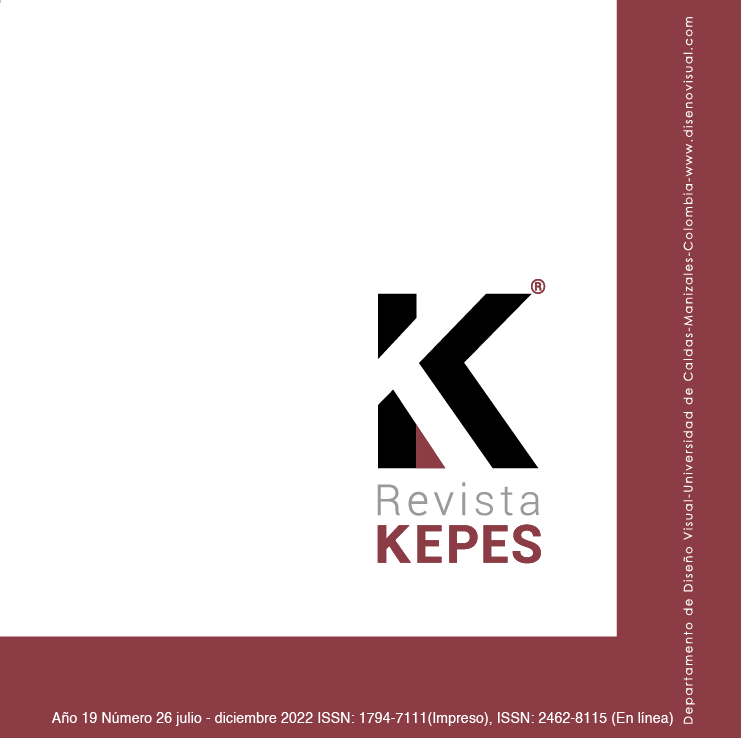Authors
Abstract
The teaching-learning process of representation techniques for architects goes through different stages in which it is required to evaluate the learning results taking into account cognitive processes and the particularities of traditional and contemporary tools that are mixed to allow to devise, develop and communicate the architectural project. This study shows a characterization of the means of representation for architecture taking into account various
variables in the design process, which are classified according to the case study raised in the subjects of the area of representation with the students of Architecture of the Universidad Nacional de Colombia, Manizales campus. The objective focuses on recognizing the relationship between the means of representation and the learning outcomes for this academic program. The method used is of a qualitative nature through recognition of workflows and
inventory of means in relation to the learning results taken from the project presented for the reform of the program and the case study in subjects of the representation area. The result of the study presents a cartography of means of representation in architecture which allows browsing and identifying different means and their characteristics associated with learning outcomes according to the type of cognition, where three types of relationships between concrete, post-concrete and formal thinking are specified as well as representation media, analog, digital and mixed.
References
Arnheim, R. (1969). Visual Thinking. University of California.
Bafna, S. (2008). How architectural drawings work—And what that implies for the role of representation in architecture. The Journal of Architecture, 13(5), 535-564. https://doi.org/10.1080/13602360802453327
Barros, C. y Barros, R. (2015). Los medios audiovisuales y su influencia en la educación desde alternativas de análisis. Revista Universidad y Sociedad, 7(3), 26-31.
Bloom, B. S. (1956). Taxonomy of educational objectives: The classification of educational goals. Cognitive Domain. https://ci.nii.ac.jp/naid/10025289849/
Carazo, E. (2018). La maqueta como realidad y como representación. Breve recorrido por la maqueta de arquitectura en los 25 años de EGA. EGA: Revista de Expresión Gráfica Arquitectónica, 23(34), 158. https://doi.org/10.4995/ega.2018.10849
Castaño, J. E., Bernal, M. E., Cardona, D. A. y Ramírez, I. C. (2005). La enseñanza de la arquitectura, una mirada crítica. Revista Latinoamericana de Estudios Educativos, 1, 125-147.
CESU - Consejo Nacional de Educación Superior. (2020). Acuerdo 02. Ministerio de Educación Nacional. https://www.mineducacion.gov.co/1759/articles-399567_recurso_1.pdf
Costa, J. (1998). La esquemática: Visualizar la información (Vol. 26). Editorial Paidós.
Cross, N. (2011). Design Thinking: Understanding How Designers Think and Work. Berg.
Eysenck, H. J. (2003). Creativity, personality and the convergent-divergent continuum. En Critical creative processes (pp. 95-114). Hampton Press.
Gänshirt, C. (2012). Tools for Ideas: Introduction to Architectural Design. Walter de Gruyter.
Goldschmidt, G. (1989). Problem representation versus domain of solution in architectural design teaching. Journal of Architectural and Planning Research, 6(3), 204-215.
Herbert, D. M. (1988). Study Drawings in Architectural Design: Their Properties as a Graphic Medium. Journal of Architectural Education, 41(2), 26-38. https://doi.org/10.1080/10464883.1988.10758473
Hernández, C. A. (2005). Para ejercer el oficio de maestro. Al Tablero, 34.
Lerner, F. (2005). Foundations for Design Education: Continuing the Bauhaus Vorkurs Vision. Studies in Art Education, 46(3), 211-226. https://doi.org/10.1080/00393541.2005.11650075
Lino, S. F., Cristeli, P. y Nunes, N. (2019). Dibujo (experimental) de arquitectura. Tsantsa: Revista de Investigaciones Artísticas, 7, 155-159.
McLuhan, M. (2009). Comprender los medios de comunicación: Las extensiones del ser humano. Grupo Planeta (GBS).
Oxman, R. (2004). Think-maps: Teaching design thinking in design education. Design Studies, 25(1), 63-91. https://doi.org/10.1016/S0142-694X(03)00033-4
Pallasmaa, J. (2009). The Thinking Hand: Existential and Embodied Wisdom in Architecture. Wiley.
Perrenoud, P. (2001). La formación de los docentes en el siglo XXI. Revista de Tecnología Educativa, 14(3), 503-523.
Pevsner, N. (1982). Las academias de arte: pasado y presente. Ediciones Cátedra.
Piaget, J. (2003). Cognitive Development in Children—Piaget Development and Learning. Journal of Research in Science Teaching, 40.
Picon, A. (2006). Arquitectura y virtualidad: Hacia una nueva condición material. ARQ (Santiago), 63, 10-15. https://doi.org/10.4067/S0717-69962006000200002
Purcell, A. T. & Gero, J. S. (1998). Drawings and the design process: A review of protocol studies in design and other disciplines and related research in cognitive psychology. Design Studies, 19(4), 389-430. https://doi.org/10.1016/S0142-694X(98)00015-5
Ross, D. (2014). The Death of Drawing: Architecture in the Age of Simulation. Routledge.
Rusch, C. W. (1970). On Understanding Awareness. Journal of Aesthetic Education, 4(4), 57-79. https://doi.org/10.2307/3331286
Sainz, J. (2017). El dibujo de arquitectura. Reverte.
Sainz, J. y Avia, J. S. (2005). El dibujo de arquitectura: Teoría e historia de un lenguaje gráfico. Reverte.
Salas, W. A. (2005). Formación por competencias en educación superior. Una aproximación conceptual a propósito del caso colombiano. Revista Iberoamericana de Educación, 36(9), 1-11. https://doi.org/10.35362/rie3692765
Schmidt, K. (1994). Modes and mechanisms of interaction in cooperative work: Outline of a conceptual framework. Risø National Laboratory.
Shulman, L. S. (2005). Signature pedagogies in the professions. Daedalus, 134(3), 52-–59. https://doi.org/10.1162/0011526054622015
Tversky, B., & Suwa, M. (2009). Thinking with sketches. In Tools for innovation: The science behind the practical methods that drive new ideas (pp. 75–84). Oxford University Press. https://doi.org/10.1093/acprof:oso/9780195381634.003.0004
Van Sommers, P. (1984). Drawing and cognition: Descriptive and experimental studies of graphic production processes
Villada, D., Vélez, J., Escandón, P., & Salazar, C. (2020). Programa de acompañamiento y transformación curricular de pregrado en arquitectura de la Universidad Nacional de Colombia sede Manizales. Cuarto Seminario Internacional Territorios, Sustentabilidad, Movimientos Sociales y Arquitectura, Veracruz, México. https://www.uv.mx/pozarica/arquitectura/files/2020/08/4%C2%B0-Seminario-Internacional-CONVOCATORIARIISPSURA-ampliada_VAR-1.pdf
Zabalza, M. A. (2009). O ensino universitário. Artmed Editora.

 PDF (Español)
PDF (Español)
 FLIP
FLIP






















